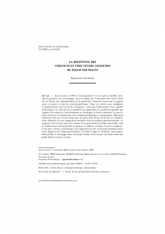La réception des Vorlesungen über neuere Geometrie de Pasch par Peano
The Reception by Peano of Pasch's Vorlesungen über neuere Geometrie

- Consulter un extrait
- Année : 2006
- Fascicule : 2
- Tome : 12
- Format : Électronique
- Langue de l'ouvrage :
Français - Class. Math. : 01A55, 03-03
- Pages : 249-290
- DOI : 10.24033/rhm.41
Peano écrit en 1888 le Calcolo geometrico. Un an après, il publie I principii di geometria, où il développe, dans le sillage des Vorlesungen über neuere Geometrie de Pasch, une axiomatisation de la géométrie. Comment concevoir le rapport entre ce projet et celui du calcul géométrique ? Dans cet article, nous soulignons le profond fossé entre les deux entreprises : alors que l'élaboration d'une algèbre géométrique vise chez Peano à manifester la singularité des grandeurs spatiales par rapport aux nombres, l'axiomatisation se développe de façon autonome et sans aucune référence à la distinction entre entités géométriques et numériques. Mais nous montrons dans un second temps que la façon dont Peano lit Pasch est complètement tributaire de son engagement antérieur dans la tradition grassmannienne : le segment $AB$ n'est pas, pour lui, comme il l'est pour Pasch un objet observable, mais le résultat d'un certain produit de points. Le tableau, au final, est assez complexe : d'une part, calcul et axiomatique sont supportés par des conceptions fondamentalement opposées de l'objet géométrique ; en même temps, la méthode axiomatique, telle qu'elle se développe dans I principii, résulte d'une lecture de Pasch selon une grille élaborée dans le Calcolo.
Pasch, Peano, calcul géométrique, axiomatique

